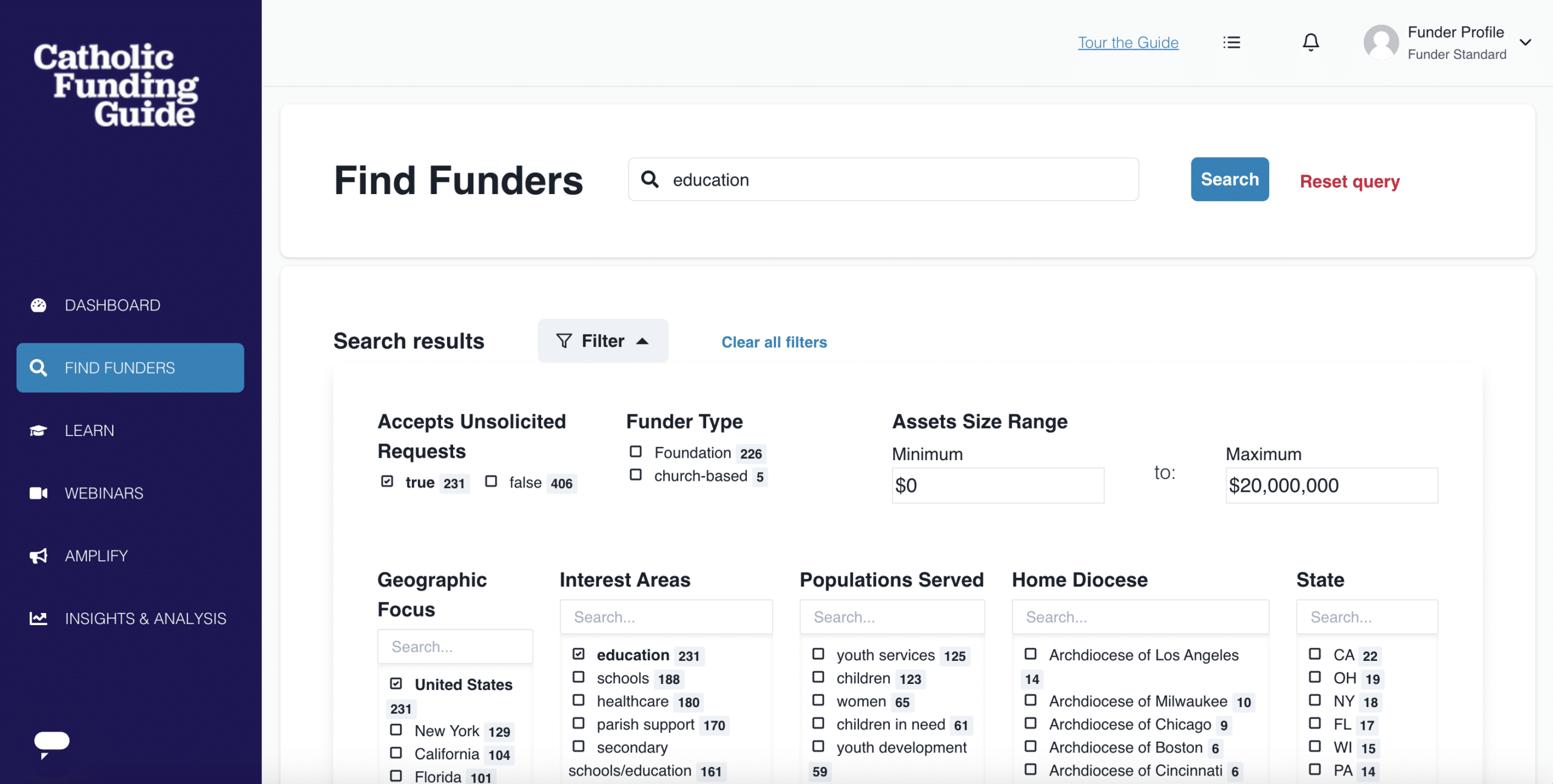Myth #1: When a funder says “No” it means “Not ever.”
Rejections can be difficult. When you spend time putting together a grant proposal, it isn’t easy to hear the answer “no.” Some grant seekers may believe this means the foundation is now a dead end; that the no means “Not ever”—a hard stop for any project in the future.
However, a “no” could mean “not yet.” Many funders plan years ahead. Perhaps they do not have the budget or resources to support your project at this time, but they might in the future.
A “no” could also mean “not this project.” In the future you may have a project that does meet their goals and align with their mission.
You can always ask why a proposal was rejected, and if the foundation would like you to reach out in the future.
Myth #2: Grant seeking is all about finding money.
Philanthropy, especially faith based philanthropy, should always center around impact. Money is a necessary part of that, of course; but it should not be your primary focus, both in your heart and in your approach to funders.
Keep in mind your “why.” Why are you seeking funding? Keep your end goal in mind, and let this shape how you approach any funder. Remember that you and the funder have something in common: the desire to fulfill a shared mission.
A funder will tell you the very same:
“It really is important, [from] my point of view, to not be seeking money. … You’re trying to seek an impact. There’s something you’re trying to do that you can’t do if they don’t say ‘yes,’ and if you’re not really authentically thirsty for that…it can give an impression that you would say anything to get the money.”
Joseph Womac, President of the Specialty Family Foundation
This quote is from a webinar available on demand for subscribers.
Grant seeking is about relationship building, trust, connections, and a shared mission to do good. Catholic and faith based fundraising, in particular, is based on sharing a mission to do the work of the kingdom.
Myth #3: It is never worth it to reach out to a funder if your missions align but geographical location does not.
It is true that geographical limitations are usually non-negotiable.
However, this does not mean that you should never contact a funder who supports work outside of your geographical area.
If you do find a funder who seems like a good fit for your mission, it can be helpful to reach out, acknowledging that your geographic location is not a match, but emphasizing your shared mission. At the very least, you could ask them for a referral to other funders who may share your location and your mission.
In rare cases, there may be some leeway regarding geographical focus. You will never know unless you reach out.
Myth #4: It is not appropriate to ask for feedback or referrals especially after a rejection.
After a proposal is rejected, many grant seekers are tempted to view that route as a dead end (which we touched on in dispelling Myth #1 above). Asking for feedback or a referral is often the last thing you want to do when the answer is no.
However, keep in mind that many funders desire to help nonprofits in any way they can, financially and otherwise. They will likely be happy to refer you to other funders who may be a better fit or a more timely prospect for your work.
While the idea of asking can be daunting, this is one way to improve your grant writing and overall approach—and it could lead you to more prospects.
Listen to what Tara Doyon, Director of Operations and Senior Consultant with Petrus Development, shared in one of our subscriber-exclusive webinars about what to do after a rejection.
Myth #5: Grant seeking for operating support is a fruitless endeavor.
Although it can be especially challenging to find funding for operating support, some funders do offer unrestricted grants. Some funders, particularly in the Catholic school sector, are adopting creative giving trends to cover operating costs, relieve debt, and more.
You can use resources such as the Catholic Funding Guide to identify funders who express interest in providing general or operating support. With a subscription to the Guide, you can also post your project for funders to search.
If you are searching for operating support, remember to always emphasize the impact that the support will have on your overall mission.
Two funders offer advice on how to make a case for operating support:
“Understand, what does an individual foundation fund? If they clearly say we don’t support operating or a certain percentage of it, recognize that, and [find] a way to reframe it. … [Y]ou’re presenting your mission. … What is the gap you’re trying to fill? … You’re really saying this is the full impact that our organization can have, and we want you to invest in that.”
Margaret H. Eigsti, MSW, Senior Program Officer of the Sisters of Charity Foundation of Cleveland
“Never talk about the lights. It’s real, but don’t.”
Christine L. Healey, President of the Healey Education Foundation
When you demonstrate how operating support has a deeper impact on your shared mission, you can win grants and support, even for operating costs.
Myth #6: Grant seeking is more important than finding and stewarding individual donors.
Because of the large dollar amount generally associated with grants, and because of the pressure you may be under to win them, you may be under the impression that grant seeking is the most important endeavor.
Grant seeking is important, but so are the other aspects of fundraising and stewarding your donors. It can be easy to forget that most US giving does not even come from grants; it comes from individuals.
A 2016 article from Philanthropy Roundtable cites that 80% of US giving came from individuals, with 71% coming from living individuals, and 9% from bequests. The article states:
“It’s easy, amid press stories about the projects of large foundations or corporations, to forget that the vast bulk of American philanthropy is carried out by individuals. Between individual donations and bequests in wills, personal gifts come to over four times as much, every year, as what behemoths like the Gates, Ford, Walton, etc. foundations plus corporations give away.”
(Source: https://www.philanthropyroundtable.org/almanac/statistics-on-u-s-generosity/)
The trend continued the following year. According to Nonprofits Source, 81% of all US giving came from individuals in 2017. (Source: https://nonprofitssource.com/online-giving-statistics/)
And even in the throes of the pandemic, in 2021, 76% of all US giving came from individuals. (Source: https://www.philanthropyroundtable.org/giving-usa-report-shows-2021-charitable-giving-strong-but-did-not-keep-pace-with-inflation/)
Clearly, the driving force behind American philanthropy is the individual donor.
This is why it is so important to divide your efforts among grant seeking, grassroots fundraising, and donor retention. Host fundraisers and donor appreciation events; find ways to reach potential donors through various channels; send a thoughtful end of year appeal; create a solid donor retention strategy.
Myth #7: If your grant proposal is rejected, the funder must not have liked you, or you did something wrong.
A rejection can feel personal, especially if you’ve been seeking funding for the same project for a while. However, this is unlikely to be the case. Funders have many reasons for rejecting a proposal, with mission alignment and conflicting priorities generally at the top of the list.
Sometimes a funder might be impressed with your project, but their funds are spoken for through the next several years. Perhaps that particular project was not a good fit, but your overarching missions align.
A rejection can be a learning opportunity. You can respectfully ask why the proposal was rejected and if they have any feedback to offer. Furthermore, you can ask for a referral and inquire whether they are interested in hearing from you in the future.
Myth #8: You just need a one-size-fits-all proposal for every grant application.
A standard proposal may sound appealing to the busy grant seeker, but currently, this is not best practice. There may be segments of your application that you can copy and paste, but as a whole, the grant proposal must be tailored to each foundation.
A personalized proposal helps you clearly make your case for why your project is a fit for their specific mission.
Recently, some funders have begun advocating for a common grant application to cut down on preparation time for nonprofits. At the same time, there is currently no widespread standard application; and many foundations have specific criteria or functions that make it necessary for them to ask different questions and take a unique approach.
When a funder sees that you cared enough to tie in your work and mission to theirs, they are likely to give it deeper consideration and remember your organization.
Myth #9: You do not need a specific budget for an effective grant proposal.
Even for operating grants, it’s best to have a specific and clear plan for how you will use the money.
This is necessary to make a strong case that you will be a responsible steward of the funds you receive and will reassure the funder that they are able to carry out their mission together with you.
Myth #10: You can spend the grant money at your discretion vs the agreed upon budget.
If challenges arise during the project, it is your responsibility to let the funder know and have a conversation with them about it before making any changes.
There are two main reasons you ought to avoid this scenario. For one, you may be legally required to repay funds if they are not used in the agreed upon way. So you may need them to approve any changes.
For another, using the funds differently than specified can harm your relationship with the funder and may curtail future opportunities if they share what happened.
Spending grant money at your discretion, without consulting them first, can come off as disrespectful and irresponsible, even if you have a good motive. Most funders will be understanding when roadblocks and unexpected changes occur during a project. If you come to them for help, they will likely be happy to assist you however they can, including approval of budget changes.
Myth #11: It does not matter how you reach out to a funder to inquire about a grant, as long as you reach out.
Some funders specify how they wish to be contacted, whether that is by phone, email, or mail. Find out and respect their preferred method of communication, and they will appreciate the effort.
If there is no specified method of communication, you can reach out with the information that is available.
If there is no contact information at all, you may be able to find more information by networking with foundation board members or organizations that received funding previously.
Finally, if a foundation is by invitation only, you can reach out to discover why they are by invitation only and how it might be possible to get on their radar. You can also research organizations that received funding from them previously to gain more insights about their giving patterns.
Myth #12: If your organization has a high overhead cost, you won’t be able to get funding.
There is a prevalent misconception among funders that a high overhead cost is a sign of poor money management. Conversely, many funders believe that a low overhead cost is a sign of a well-run nonprofit. The nonprofit starvation cycle, which we discuss in another blog post, comes into play here.
Although this is the traditional belief, funders are increasingly open to the idea that it may take a high overhead to run effective programs. If you can demonstrate financial responsibility and make a case for how your budget makes a lasting impact on those you serve, many funders will hear you out.
In addition, of course, be sure to present a strong grant proposal and case for support.
Are you looking for a way to find funding, faster? Find out how the Catholic Funding Guide can be a companion on your fundraising journey.



